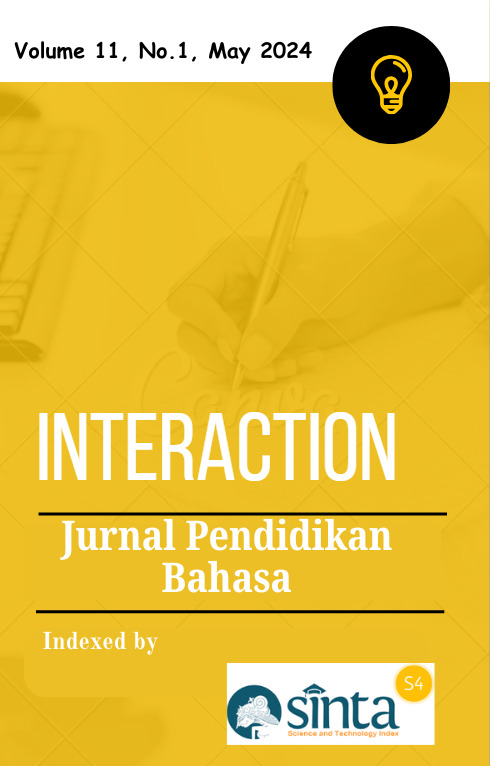English Teaching: Bibliometric Analysis of Artificial Intelligence and English Teaching
Abstract
The phenomenon of Artificial Intelligence nowadays has spread over the world, especially in education. The involvement of Artificial Intelligence in English teaching is essential to study because it shows the trend of how English is taught with the development of AI. The aim of this study is to uncover the trend of Artificial Intelligence and English teaching from 2013 to 2022. This study applied quantitative descriptive method. To find the trend of Artificial Intelligence and English teaching, the data were gathered from Publish or Perish application (PoP) and then visualized by using Vosviewer. To process the data, bibliometric analysis was applied. The data of the study indicates there were 791 publications concerning artificial intelligence and English teaching from 2013 to 2022. Furthermore, the data from 2013 to 2022 related to Artificial Intelligence and English teaching indicates that the number of studies concerning these keywords were gradually increasing from year to year where the year “2021” became the year where the highest number of studies related to Artificial Intelligence were published. Bibliometric analysis in this study showed that the publications concerning Artificial Intelligence and English teaching from 2013 to 2022 were increasing year by year. This finding implies that people now are familiar with applications of technology such as AI in English teaching. Thus, this study can give visualization to other researchers about AI and English teaching. The researcher can explore more detail about the use of Artificial Intelligence in teaching, especially in English teaching.
Downloads
References
Aisyah, S., Noviyanti, E., & Triyanto. (2020). Bahan Ajara Sebagai Bagian daam Kajian Problematika Pembelajaran Bahasa. Salaka, 2(1), 62–65.
Asmirantho, E., & Yuliawati, E. (2015). Pengaruh Dividen Per Share (Dps), Dividen Payout Ratio (Dpr), Price To Book Value (Pbv), Debt To Equity Ratio (Der), Net Profit Margin (Npm) Dan Return on Asset (Roa)Terhadap Harga Saham Pada Perusahaan Manufaktur Sub Sektor Makanan Dan Minuman Dalam Kema. JIAFE (Jurnal Ilmiah Akuntansi Fakultas Ekonomi), 1(2), 95–117. https://doi.org/10.34204/jiafe.v1i2.525
Donthu, N., Kumar, S., Mukherjee, D., Pandey, N., & Lim, W. M. (2021). How to conduct a bibliometric analysis: An overview and guidelines. Journal of Business Research, 133, 285–296. https://doi.org/https://doi.org/10.1016/j.jbusres.2021.04.070
Fitriyani, Y., Fauzi, I., & Sari, M. Z. (2020). Motivasi Belajar Mahasiswa Pada Pembelajaran Daring Selama Pandemik Covid-19. Profesi Pendidikan Dasar, 7(1), 121–132. https://doi.org/10.23917/ppd.v7i1.10973
Garcia Castro, R. A., Chura-Quispe, G., Velarde Molina, J. F., Espinoza Ramos, L. A., & Almonte Durand, C. A. (2024). Bibliometric review on teaching methods with artificial intelligence in education. Online Journal of Communication and Media Technologies, 14(2), e202419. https://doi.org/10.30935/ojcmt/14367
Glänzel, W. (2003). Bibliometrics as a research field: A course on Theory and Application of Bibliometric Indicators. Researchgate, January 2003, 115. https://www.researchgate.net/publication/242406991_Bibliometrics_as_a_research_field_A_course_on_theory_and_application_of_bibliometric_indicators
Hartono, W. J., Nurfitri, Ridvan, Kase, E., Lake Floribertha, Sandra, R., & Zebua. (2023). Artificial Intelligence (AI) Solutions In English Language Teaching: Teachers-Students Perceptions And Experiences. Journal on Education, 06(01), 1452–1461.
Huang, J., Saleh, S., & Liu, Y. (2021). A review on artificial intelligence in education. Academic Journal of Interdisciplinary Studies, 10(3), 206–217. https://doi.org/10.36941/AJIS-2021-0077
Ilham, R., Giatman, M., & Maksun, H. (2024). Artificial Intelligence Research in Education: A Bibliometric Analysis Rozali. Journal on Education, 6(02), 13467–13479. https://doi.org/10.21125/edulearn.2022.1300
Iriyani, S. A., Patty, E. N. ., Rahim, A., Awaliyah, M., & Ria, R. R. P. (2023). Tren Manajemen Pendidikan: Analisis Bibliometrik Menggunakan Aplikasi Vosviewer. Edu Cendikia: Jurnal Ilmiah Kependidikan, 3(01), 93–100. https://doi.org/10.47709/educendikia.v3i01.2281
Jiang, A. L., Sun, K., & Qin, T. L. (2024). Unraveling the relationships among EFL teacher emotions, immunity, and teaching quality: A multilevel structural-equation modelling analysis. System, 124. https://doi.org/10.1016/j.system.2024.103356
Lubis, A. H., Samsudin, D., Triarisanti, R., Jerusalem, M. I., & Hwang, Y. (2024). A Bibliometric Mapping Analysis of Publications on The Utilization of Artificial Intelligence Technology in Language Learning. Journal of Advanced Research in Applied Sciences and Engineering Technology, 38(1), 156–176. https://doi.org/10.37934/araset.38.1.156176
Peltzer, K., Lira Lorca, A., Krause, U.-M., & Busse, V. (2024). Effects of formative feedback on argumentative writing in English and cross-linguistic transfer to German. Learning and Instruction, 92. https://doi.org/10.1016/j.learninstruc.2024.101935
Pertiwi, R., Suchyadi, Y., Sumardi, & Rukmini. (2019). Implementasi program pendidikan karakter di sekolah dasar negeri Lawanggintung 01 Kota Bogor. Journal of Elementary School Teacher Education and Teaching/ Jurnal Pendidikan & Pengajaran Guru Sekolah Dasar, 2(1), 41–46. http://journal.unpak.ac.id/index.php/jppguseda,
Rukiati, E., Wicaksono, J. A., Taufan, G. T., & Suharsono, D. D. (2023). AI on Learning English: Application, Benefit, and Threat. Journal of Language, Communication, and Tourism, 1(2), 32–40. https://doi.org/10.25047/jlct.v1i2.3967
Su, J., Ng, D. T. K., & Chu, S. K. W. (2023). Artificial Intelligence (AI) Literacy in Early Childhood Education: The Challenges and Opportunities. Computers and Education: Artificial Intelligence, 4(November 2022), 100124. https://doi.org/10.1016/j.caeai.2023.100124
Triansyah, F. A., Muhammad, I., Rabuandika, A., Siregar, K. D. P., Teapon, N., & Assabana, M. S. (2023). Bibliometric Analysis: Artificial Intelligence (AI) in High School Education. Jurnal Imiah Pendidikan Dan Pembelajaran, 7(1), 112–123. https://doi.org/10.23887/jipp.v7i1.59718
Wong, D. (2018). VOSviewer. Technical Services Quarterly, 35(2), 219–220. https://doi.org/10.1080/07317131.2018.1425352
Zawacki-Richter, O., Marín, V. I., Bond, M., & Gouverneur, F. (2019). Systematic review of research on artificial intelligence applications in higher education – where are the educators? International Journal of Educational Technology in Higher Education, 16(1). https://doi.org/10.1186/s41239-019-0171-0




.png)



22.png)
